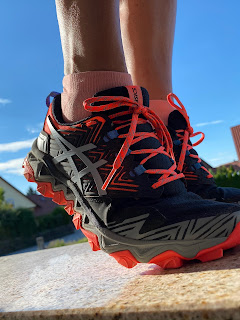 |
| Another victim of the Scottish fell terrain |
And if you’ve ever tried fell running in the British Isles it’s even more difficult, because when your foot disappears beneath that heather, it’s anyone’s guess as to what it will land on. If you are lucky, it’s hard flat ground, but more often than not it is a rut, or soft marsh, or a water bog, or a hole which sucks you down to your hip (yes).
Given those obvious difference between trail/fell and road running, there must be corresponding differences in training, right? Absolutely! Aside from putting in those miles on the trails, doing some additional leg work for the adductors needed for jumping zig-zag from rock to rock, and of course the exercises for eccentric muscle contractions (used when running downhill…ouch!), there is another aspect that should not be over-looked, namely, foot and ankle strength. Sound boring? Well, maybe it is, but ankle strengthening exercises are a lot less boring than spending 3 weeks on the couch due to a rolled ankle!
 |
| What the Scottish hills did to my ankles |
I used to think that running regularly on the uneven trails
was enough to keep my ankles strong, but I learned that lesson the hard way with
two sprained ankles in the past two years, the last of which was only 3 hours
into a two-day mountain marathon in Scotland, which I ended up finishing only
due to the ice-cold temperature of the water that we were constantly sloshing
through which kept my feet numb.
So, how can we keep our ankles strong? The same way we keep
our arms and core strong: Focused strengthening exercises. But no fear, these
can actually be fun, ranging from slacklining to jump-roping to stabilization
exercises in your living room while watching ‘How I Met Your Mother’ re-runs.
My top choices for fun training that doesn’t feel like
training:
- Slacklining: Strengthens not only the feet, ankles and legs
muscles but also the core
- Jump roping (go look in your child’s toy box, there has got to be one in there somewhere)
 |
| Love my ASICS GEL-Fujitrabucos for the trails |
Top choices for focused strengthening:
- Balance. Stand on one foot and roll up onto the toes, hold for
a second, then down. Three reps of 10 on each foot. Daily. You can even do
this while brushing your teeth.
- Toe Jumping. Stand on one foot, roll up onto the toes and jump
from side to side and front to back. This is not only an excellent ankle strengthening
exercise which simulates actual foot behavior in technical trail running,
but it is also an excellent aerobic workout. See how long you can do this
without getting out of breath!
- Mobility. This one is awesome and can actually be done while
chilling on the couch. You are simply going to move your feet and ankles
in all directions to the limit of their range: flex and point; rotate in
both directions; point toes inward, then outward. Then bend the knees to
about 90°
so that the feet are flat on the couch and act as though you are picking
up a marble or other small object with your toes. Lift your toes, keeping
your ankles in place. Then release the toes at their highest point.
Repeat. Ten times each side.
Having strong ankles will not only keep you from getting
injured, but it also it helps with self-confidence. Knowing that you can trust
your feet on those loose rocks and down-hill trails provides that extra
confidence to notch up the pace.
 |
| Don't drop the proverbial ball on this one. Keep those ankles strong! |

No comments:
Post a Comment